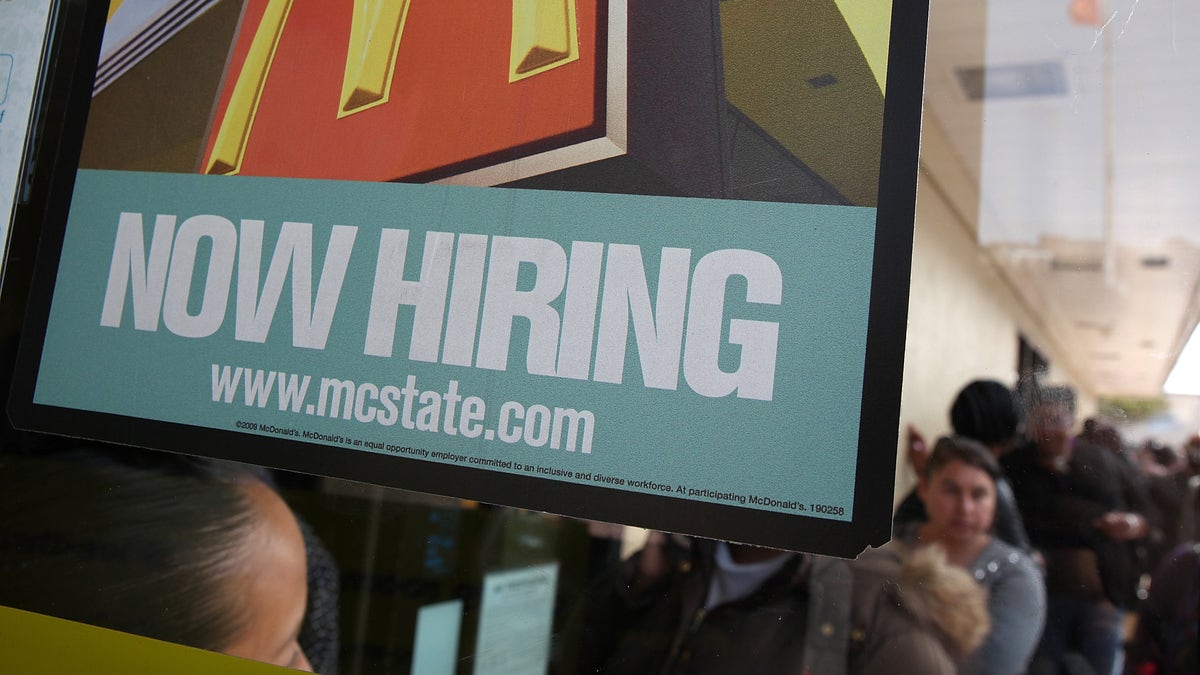
SAN FRANCISCO, CA - APRIL 19: Job seekers wait in line to be interviewed during a one-day hiring event at a McDonald's restaurant on April 19, 2011 in San Francisco, California. Hundreds of job seekers filled out applications and were interviewed at a San Francisco McDonald's restaurant during a one-day nationwide event at the chain as they look to fill 50,000 positions at stores nationwide. (Photo by Justin Sullivan/Getty Images) (2011 Getty Images)
President Obama’s $800 billion stimulus boondoggle failed to meet most of the President’s own benchmarks for economic recovery. As a result of his missed opportunity, the current recession is longer and deeper than any since World War II.
Of the 11 recessions in the postwar era, 10 had recouped all of their job losses after 49 months. Fifty-nine months after the start of the 2007 recession, America’s economy still has 3 percent fewer jobs than when we started.
Every state should aim to develop a jobs training program tailored to its own local industry.
So why did the federal government fail so spectacularly in its efforts to kick-start job growth?
A considerable portion of the Obama stimulus focused on direct capital investment: taxpayer money handed out to fledgling companies to catalyze their growth.
But the companies that received these handouts weren’t necessarily those most poised for expansion — they were those whose owners had donated the most to the Obama campaign. So money flowed to the Solyndras of the world — it was crony capitalism at its worst, and high unemployment has lingered.
The best thing that government can do to create jobs is to get out of the way by easing the tax and regulatory burden on small businesses.
But there is also a more proactive step government can take to facilitate job growth: direct investment to jobs training programs on state university and community college campuses.
Most states have a government-run workforce development scheme. But too often, these programs are ineffective and subject to bureaucratic inertia. In New York, for example, our workforce development program is a jumbled mess: 28 different funding schemes are accountable to 11 different agencies and plagued by a pervasive lack of coordination and collaboration.
There is a more cost-effective solution: state universities and community colleges provide a better training environment and more meaningful career counseling thanks to their relationships with local industries that can communicate their specific needs for new workers.
Job training programs specifically tailored to the needs of local industries will help close the skills gap between the number of emerging jobs with high-skill requirements and the comparably small number of workers with those skills.
This year, New York will look to redirect our job training funds directly to state and community colleges for the purpose of consolidating and streamlining our ability to train new workers.
This model has worked for other states. North Dakota's “TrainND” program works with the private sector to fund community colleges for the purpose of providing worker training to meet employer-defined needs.
Williston State College has used the program to grow the number of workers it trains from 3,000 to over 10,000 annually. Graduates of the program have a 98 percent job placement rate.
Alexandria Community and Technical College in Minnesota has also been reactive to local industry, working with major manufacturers to train workers for jobs that will be waiting for them upon graduation.
While we’re looking to build on this model in New York in 2013, we’ve already had some success.
Hudson Valley Community College's TEC-SMART facility is a joint initiative between the college and the New York State Energy Research and Development Authority. The facility provides training classrooms in semiconductor manufacturing technology, as well as labs and classrooms for training in renewable energy technologies like solar, wind and geothermal power.
The program graduates workers with skill sets tailor-made for jobs in local industry.
Every state should aim to develop a jobs training program tailored to its own local industry.
Federal funding, rather than being funneled to companies doomed to fail to repay campaign donors, should go to states for the purpose of developing these programs, or directly to employers to offset the cost training new workers, as is being done successfully in North Dakota and Minnesota.
Government has a role to play in facilitating job growth, but should not be in the business of picking winners in the private sector. When they do, everybody loses.
